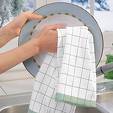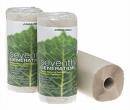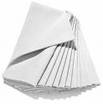
Have you ever wondered whether dishtowels are better for the environment than paper towels, or if cloth napkins are greener than paper napkins? Some argue that the energy used to make and repeatedly wash a dishtowel may exceed that used for the manufacture of a paper towel, and many argue the other way around. In the battle of paper towels and napkins versus cloth, here are the green, greener, and greenest options.
So Not-Green, At All! Paper — Virgin Fiber, Chlorine Bleached

Virgin fiber comes straight from a tree. Doesn’t it seem a waste to use a tree for a single-use item? Well how’s this: If every household in the USA replaced one roll of virgin-fiber paper towels with 100% recycled paper towels, we could save 1.4 million trees. If every household in the USA replaced just one package of virgin fiber napkins with 100% recycled ones, we could save 1 million trees. With those numbers in mind, using virgin fiber for single use items seems simply outrageous.
Next up, bleach. Gleaming, bright white paper towels and napkins don’t get that way naturally. There are several methods of bleaching paper products, some better than others. The one to avoid: Elemental Chlorine (chlorine gas). This is the worst and is responsible for the release of chlorinated compounds like dioxins and furans — powerful carcinogens and mutagens. They adversely affect immune systems and reproductive systems and are dreadful for aquatic life and wildlife. Bad, bad, bad. Elemental Chlorine Free (ECF) process
may be okay — this method employs a chlorine derivative such as chlorine dioxide rather than chlorine gas. It’s not the best choice, but is a cleaner process than the use of elemental chlorine.
Greenish: Paper—Partially Recycled, Alternative Bleaching

If you can’t find paper products made of 100% recycled paper, look for ones with at least some recycled content. Also, steer away from products bleached with elemental chlorine; instead choose ones using alternative bleaching. Process Chlorine Free (PCF) is a great choice. It doesn’t use bleach with chlorine or its derivatives. Totally Chlorine Free (TCF) is the best choice — this is pulp that has never been bleached with chlorine or its derivatives.
Green: Paper—Totally Chlorine Free, 100 Percent Recycled

There are two types of materials used in recycled paper products: Post-consumer fiber and recovered fiber. Post-consumer fibers come from paper that has already been used by the consumer and sent to recycling. Recovered fiber is from paper waste leftover in manufacturing, such as trim, scraps, unused stock. When you are buying recycled paper products, strive for 100% recycled paper with a minimum of 90% post-consumer materials. The higher the post-consumer percentage, the more paper is being saved from hitting the landfill. Also look for Totally Chlorine Free (TCF) paper towels and napkins — these are a very pretty brown color.
Greener: Cloth—Cotton

If you are careless in your treatment of cloth napkins and dishtowels (like running a load of hot-water wash for a few barely-soiled napkins), paper
can be the more eco-friendly option. But if you approach your cloth towels and napkins conscientiously, cloth is the greener option. Some say washing cloth must be more energy-intensive than using paper, but electric dryers are actually twice as energy efficient as the manufacture of paper towels. When factoring in all components of making a paper towel or napkins (harvesting the material, processing and bleaching it, packaging it, shipping it, stocking it at a supermarket, transportation to and from the store to purchase it, etc), all for a single use, we find that paper towels and napkins are about twice as energy-intensive and create more greenhouse gases overall. While cloth napkins or dishtowels may go through similar processes to get to your kitchen drawer, they will stay there for many, many years, rather than being sent directly to the landfill. Much smarter idea!
Greenest: Cloth—Recycled and/or Hemp, Linen or Organic Cotton

Buy used cloth napkins and dishtowels. There are lovely and fun ones at 2nd-hand stores, flea markets and on eBay. Consider making your own dishtowels and napkins by cutting up old sheets, towels, etc., and hemming the edges. If buying new dishtowels or napkins, remember that conventional cotton is a notoriously nasty crop in terms of pesticides, so aim for organic cotton. Alternatively, choose hemp or linen which are more sustainable than conventional cotton. Follow the tips below for the greenest use of your cloth napkins and dishtowels.
Paper Towel and Napkin Green Tips
 Purchase paper towels made of 100% recycled materials.
Purchase paper towels made of 100% recycled materials.
Look for paper products that contain a minimum of 90% post-consumer waste.
Choose unbleached paper towels. If unavailable, opt for process chlorine free (PCF) next, or elemental chlorine free (ECF) as a last choice.
Choose paper towels and napkins without added pigments, inks or dyes (say goodbye to that floral printed border).
Select packaging with minimal environmental impact, such as that from recycled and recyclable materials; imprinted with safe inks; and containing no toxic metals, dyes or inks.
Seek items having the largest amount of product to minimize packaging, for example, high-capacity hardwound roll towels have 800 feet or more. Puffier brands allow for fewer paper towels per roll or napkins per package.
Avoid folded paper towels, it is too easy to use too many of them.
Look for paper towels wound on a 100% recycled core.
Cloth Napkin and Dishtowel Green Tips
 Only wash when soiled. Most adults don’t really dirty a napkin after every meal.
Only wash when soiled. Most adults don’t really dirty a napkin after every meal.
Designate a place to store “in-use” napkins; use the same one until it is dirty.
If you have a large family, designate a napkin ring for each member to identify their napkin between meals.
Toss dirty napkins/dish towels in with other laundry.
Use eco-friendly laundry detergent.
Wash with cold water; line dry when weather permits.
Information Courtesy Care2.
(If YOU have a smart idea, won't you share it? Life is so much easier and we accomplish so much more when we pool our resources. And after all, we're all in this together. So email
patty@dvo.com or
alice@dvo.com with YOUR Smart Ideas!)
Contribute to the Cook'n Club!
DVO would love to publish your article, prose, photography and art as well as your cooking, kitchen and nutrition tips, tricks and secrets. Visit the Newsletter Submission / Win Win for All section in our Forum for more information and details.



